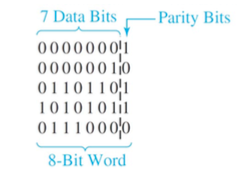Question
A Sequential Parity Generator: When binary data is transmitted or stored, an extra bit (called a parity bit) is frequently added for purposes of error
A Sequential Parity Generator: When binary data is transmitted or stored, an extra bit (called a parity bit) is frequently added for purposes of error detection. For example, if data is being transmitted in groups of 7 bits, an eighth bit can be added to each group of 7 bits to make the total number of 1s in each block of 8 bits an odd number. When the total number of 1 bits in the block (including the parity bit) is odd, we say that the parity is odd. Alternately, the parity bit could be chosen such that the total number of 1s in the block is even, in which case we would have even parity. Some examples of 8-bit words with odd parity are:

Design a Moore sequential odd-parity generator for serial data. (Serial implies that the data enters the circuit sequentially, one bit at a time.) The circuit has one input: the serial input (clock is an assumed input that provides the clock of flip-flop(s)) and one output: parity bit. Assume that there is a counter that runs in parallel with the parity generator to count the number of bits to determine when output is valid. Show all the steps.
Step by Step Solution
There are 3 Steps involved in it
Step: 1

Get Instant Access to Expert-Tailored Solutions
See step-by-step solutions with expert insights and AI powered tools for academic success
Step: 2

Step: 3

Ace Your Homework with AI
Get the answers you need in no time with our AI-driven, step-by-step assistance
Get Started


